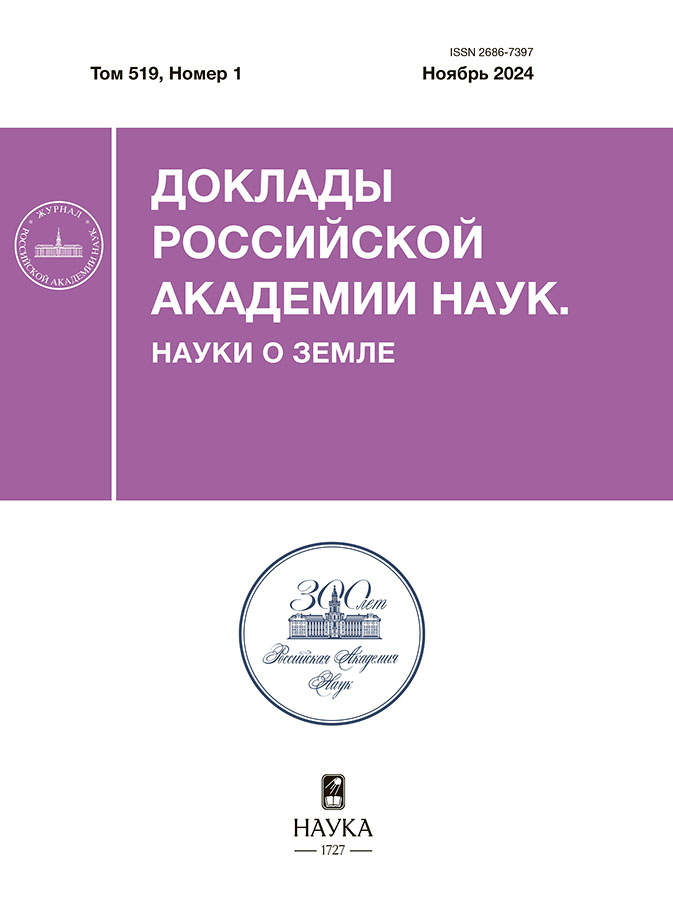Aerogravimetric measurements over Baikal
- Autores: Koneshov V.N.1, Mikhailov P.S.1
-
Afiliações:
- Schmidt Institute of Physics of the Earth, Russian Academy of Sciences
- Edição: Volume 519, Nº 1 (2024)
- Páginas: 517-526
- Seção: GEOPHYSICS
- ##submission.dateSubmitted##: 04.06.2025
- ##submission.datePublished##: 20.12.2024
- URL: https://snv63.ru/2686-7397/article/view/682437
- DOI: https://doi.org/10.31857/S2686739724110155
- ID: 682437
Citar
Texto integral
Resumo
The article presents the results of the first high-precision route aerogravimetric survey, carried out in 2023 along the “cross” profile of Lake Baikal at a flight altitude of 5300 meters. The airborne gravimetric complex used in the measurements, based on the laboratory's AN-26BRL aircraft, is described. Directly above the lake water area, the largest negative value of the measured gravity field anomaly was -180.8 mGal, the horizontal gradient of the field measurement along the profile was up to 9 mGal/km in the area of the western and up to 5 mGal/km in the area of the eastern shores of Lake Baikal. The internal convergence of anomaly values on the route profile for a complex of three instruments was 0.74 mGal. For the Baikal Rift Basin, the resolution and reliability of the most current modern global models of the Earth's gravity field UGM-SGG-2, EGM2008, XGM2019 and Sandwell and Smith v32, based on satellite data, were assessed. It is shown that the standard deviations of the field along the entire profile between the values calculated from satellite models with the number of expansion coefficients of 2190 or more from airborne gravimetric observations are 9.5 - 17.9 mGal, and the maximum deviations at individual points of the route are 40-80 mGal. Using airborne gravity profile data, a comparison was made with marine gravity survey data at a scale of 1:500,000. Due to the high detail of the data along the airborne gravity profile, it was determined that the actual value of the main negative anomaly on the airborne profile is higher than that accepted for the analysis and integrated interpretation of geophysical data in the area of Lake Baikal.
Palavras-chave
Texto integral
Sobre autores
V. Koneshov
Schmidt Institute of Physics of the Earth, Russian Academy of Sciences
Autor responsável pela correspondência
Email: paulmikh@mail.ru
Rússia, Moscow
P. Mikhailov
Schmidt Institute of Physics of the Earth, Russian Academy of Sciences
Email: paulmikh@mail.ru
Rússia, Moscow
Bibliografia
- Артюшков Е.В., Чехович П.А. Происхождение Западно-Сибирского осадочного бассейна без сильного растяжения земной коры: анализ данных сверхглубокого бурения // Доклады РАН. Науки о Земле. 2023. T. 512. № 2. С. 251‒260. https://doi.org/10.31857/S2686739723601175.
- Hutchinson D.R., Golmshtok A.J., Zonenshain L.P., Moore T.C., Schol C.A., Klitgord K.D. Depositional and Tectonic Framework of the Rift Basins of Lake Baikal from Multichannel Seismic Data // Geology. 1992. № 20 (7). P. 589–592. https://doi.org/10.1130/00917613(1992)020<0589:DA TFOT>2.3.CO;2
- Eponeshnikova L.Yu., Duchkov A.A., Sanzhieva D.P.-D., Yaskevich S.V. Three-Dimensional Velocity Structure of the Crust in Central Lake Baikal from Local Seismic Tomography // Geodynamics & Tectonophysics. 2023. № 14 (1). 0683. https://doi.org/10.5800/GT-2023-14-1-0683
- Середкина А.И. Современное состояние исследований глубинного строения земной коры и мантии Байкалького рифта по сейсмологическим данным // Физика Земли. 2021. №2. С. 46‒70. https://doi.org/10.31857/S0002333721020113.
- Zorin Yu. A., Mordvinova V.V., Turutanov E. Kh., Belichenko B.G., Artemyev A.A., Kosarev G.L., Gao S.S. Low seismic velocity layers in the Earth’s crust beneath Eastern Siberia (Russia) and Central Mongolia: receiver function data and their possible geological implication // Tectonophysics. 2002. No. 359. P. 307–327. https://doi.org/10.1016/S0040-1951(02)00531-0
- Tiberi C., Diament M., Deverchere J., Petit-Mariani C., Mikhailov V., Tikhotsky S. , Achauer U. Deep structure of the Baikal rift zone revealed by joint inversion of gravity and seismology // Journal of Geophysical Research. 2003. V. 108, Iss. B3. No. 2133. https://doi.org/10.1029/2002JB001880
- Дробышев Н.В., Конешов В.Н., Погорелов В.В., Михайлов П.С. Самолет-лаборатория для исследований гравитационного поля земли // Наука и технологические разработки. 2018. Т. 97. № 4. С. 5‒27. https://doi.org/10.21455/std2018.4-1
- NOAA National Centers for Environmental Information. 2022: ETOPO 2022 15 Arc-Second Global Relief Model. NOAA National Centers for Environmental Information. https://doi.org/10.25921/fd45-gt74. Accessed [10.11.2023].
- Pavlis N.K., Holmes S.A., Kenyon S.C., Factor J.K. The development and evaluation of the Earth Gravitational Model 2008 (EGM2008) // J. Geophys. Res. 2012. V. 117. Iss. B4. B04406. https://doi.org/10.1029/2011JB008916
- Zingerle P., Pail R., Gruber T., Oikonomidou X. The combined global gravity field model XGM2019e // Journal of Geodesy. 2020. V. 94. Article number: 66. https://doi.org/10.1007/s00190-020-01398-0.
- Wei Liang, Jiancheng Li, Xinyu Xu, Shengjun Zhang, Yongqi Zhao. A High-Resolution Earth’s Gravity Field Model SGG-UGM-2 from GOCE, GRACE, Satellite Altimetry, and EGM2008 // Research Geodesy and Survey Engineering. 2020. V. 6. Iss. 8. P. 860–878.
- Sandwell D.T., Harper H., Tozer B., Smith W.H.F. Gravity field recovery from geodetic altimeter missions // Advances in Space Reaserch. 2021. V. 68. Iss. 2. P.1059–1072. https://doi.org/10.1126/science.1258213
- Геологический отчет “Отчет по обобщению гравиметрических данных оз. Байкал и его обрамления”, УГГА “Спецгеофизика”, п. Поваровка. 1999. Книга 1 – Текст. С. 207.
- Petit C., Deverchere J. Structure and evolution of the Baikal rift: A synthesis // Geochem. Geophys. Geosyst. 2006. 7. Q11016.
Arquivos suplementares

















